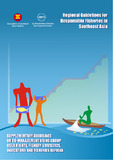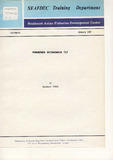Socio-Economi Study Of Trawl Fisheries In Samar Sea, Philippines
นามธรรม
Samar Sea is one of the major fishing grounds in Northwestern Samar with abundant pelagic and demersal fishery resources. In order to holistically manage the area, the Alliance of Local Government Units in Samar Sea planned to collectively manage the fishery resources using the concept of Ecosystem Approach to Fisheries Management (EAFM). However, the absence of socio-economic data as baseline for assessing and monitoring socio-economic impacts of proposed management actions is one of the important missing information. Therefore, a socio-economic study of trawl fisheries in the Samar Sea was conducted to gather baseline information for the formulation, implementation, monitoring and evaluation purposes of the proposed fishery management measures and contribute to the Samar Sea Fisheries Management Plan (SSFMP) to address its impact on affected fisher folks.
The socio-economic survey covered both commercial trawls (fish and shrimp trawls) and smaller-scale municipal trawls (shrimp and squid trawls) with a total of 517 respondents and examined age composition, participation of female fishers, and also education. Majority of the respondents were male (99% in commercial fish trawls and 92.5% in commercial shrimp trawls). Most of the fishermen were between 25 to 44 years of age. In general, fishers’ education was inadequate with many only with elementary level education.. Most respondents were not members of any organization but those that were listed as part of an organization were members of fisherfolk association which is the most common type. Extended families exist among the respondents. In all types of trawling households, both commercial and municipal, the son, daughter and wife are the primary household members who stay with the respondents.
Fishing was the most dominant source of livelihood of household members. Farming, teaching, carpentry, overseas work, fish processing, aquaculture, livestock rearing, fish brokering and ancillary fishing related occupations were among the household members’ livelihood sources. Access to credit is very low and correspond with the low membership in associations. There is a need for training on basic safety at sea as in general very minimal life-saving equipment and materials are onboard.
The municipal trawler with a 10-16 hp engine seems to be operate more profitably than the municipal trawler with a 80 hp engine, considering operational costs vs. net profit derived from their operations as well as the income for fishermen.
การอ้างอิง
Ramiscal, R., Dickson , J., Lamara , N., Efren V. , H., & Romero , R. (n.d.). ocio-Economi Study Of Trawl Fisheries In Samar Sea, Philippines. Training Depart, Southeast Asian Fisheries Development Center
คอลเลกชัน
- Country Activities [95]
รายการที่เกี่ยวข้อง
แสดงรายการที่เกี่ยวข้องตามชื่อผู้แต่งผู้สร้างและเรื่อง
-
Regional Guidelines for Responsible Fisheries in Southeast Asia Supplementary Guidelines on Co-Management Using Group User Rights,Fisheries Statistics, Indicators and Fisheries Refugia
SEAFDEC,ASSOCIATION OF SOUTHEAST ASIAN NATIONS (SEAFDEC, 2006-03)The Guidelines on “Use of Indicators for the Sustainable Development and Management of Capture Fisheries” which is to large extent related to fishery statistics, was developed to complement the programs on statistics, thus, ... -
Fisheries Economics (I)
Yamao, Masahiro (Training Department, Southeast Asian Fisheries Development Center, 1987-01)This textbook was initially prepared as part of the lectures on Fisheries Economics at SEAFDEC, in 1986. The contents are obviously not only introductory but also essential to our subject. In addition to my summarized ... -
SEAFDEC Seminar 2018: Fisheries and Marine Environment
Southeast Asian Fisheries Development Center, Training Department (Training Department, Southeast Asian Fisheries Development Center, 2018)Proceeding of SEAFDEC Seminar 2018: Fisheries and Marine Environment




